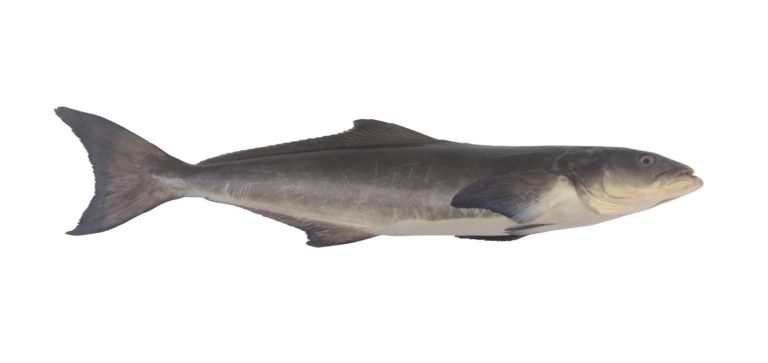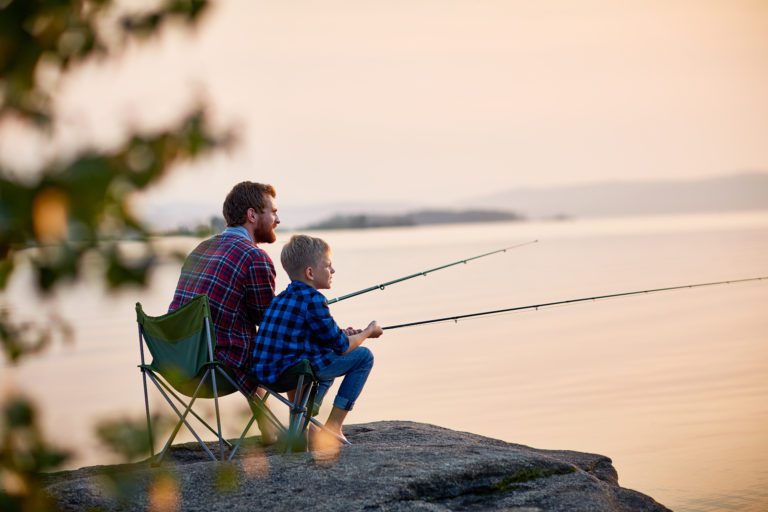Mastering the Art of Sheepshead Fishing: A Step-by-Step Guide on How to Catch Sheepshead in Florida
Wondering how to catch Sheepshead in Florida with ease? Look no further. This concise guide streamlines the process, bringing you tips straight from the experts. Learn about Sheepshead behaviors, their preferred hangouts, and the prime times for fishing. Find out about the gear you’ll need and baiting techniques that actually work. We’ll guide you step-by-step, so expect to boost your catch rate after reading this!
Key Takeaways
- Sheepshead prefer habitats rich in prey like crabs and love to feed around structures; timing is key with the best months being March and April.
- Use medium-heavy rods for sensitivity to detect subtle bites, spool reels with 10-20 lb. braided line, and opt for small, stealthy hooks like #1 Octopus hooks.
- Live bait like shrimp and crabs are most effective; present your bait close to structures and use rigs like the Carolina or Sliding Sinker to keep the bait near the bottom.
Unlocking the Secrets of Florida Sheepshead Fishing
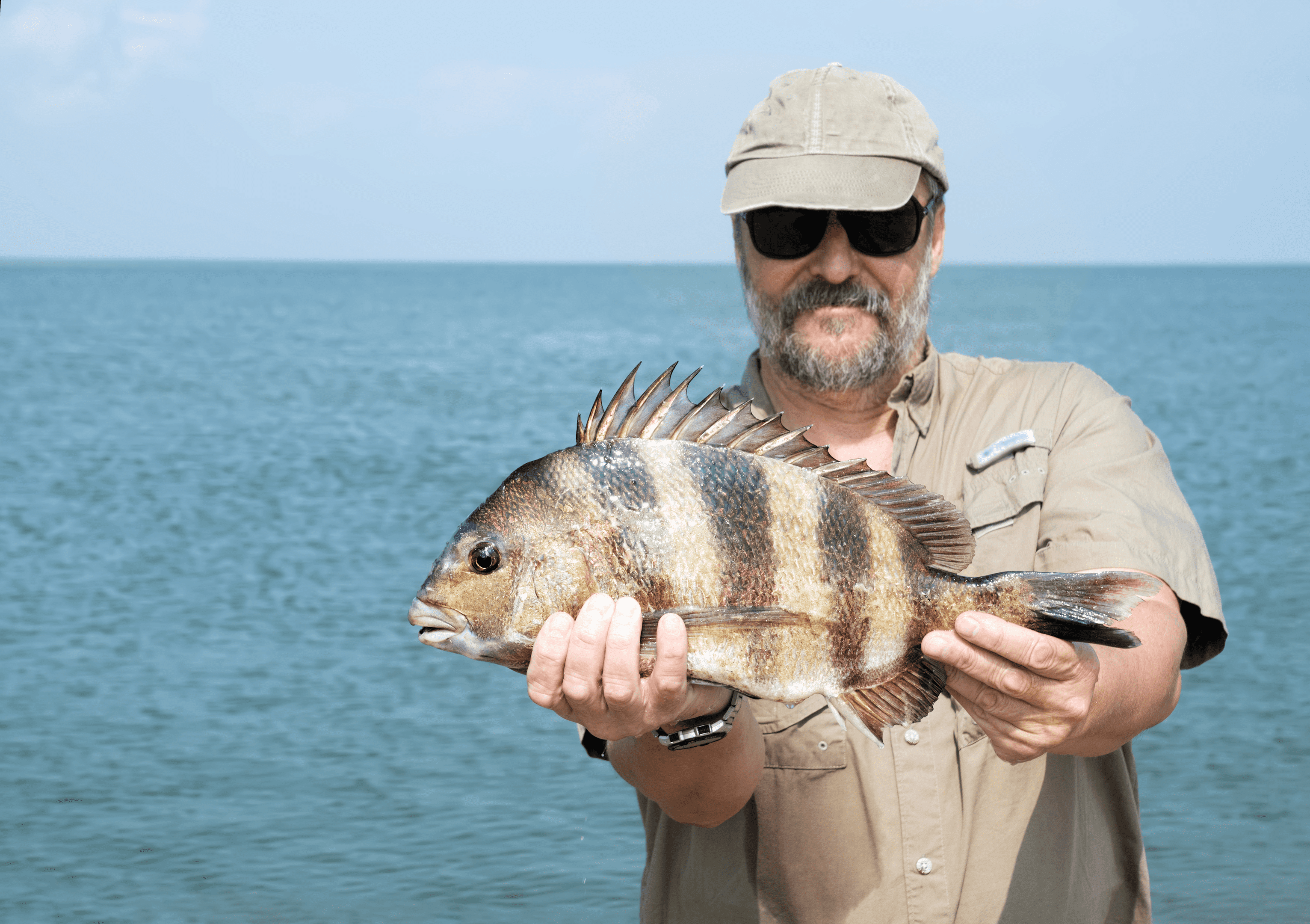
Sheepshead fishing in Florida isn’t just about casting a line and hoping for the best. It’s about understanding the fish, their habits, and the environments in which they thrive. These elusive fish are commonly found around fishing docks, bridge pilings, and other underwater structures, providing ample fishing opportunities for those in the know. They love areas where freshwater meets salty estuaries, and South Florida, in particular, is renowned for its inshore fishery, offering abundantly populated waters with Sheepshead.
Gaining insight into the seasonal patterns of Sheepshead can provide the advantage you require. During certain times of the year, Sheepshead tend to migrate from deeper, cooler waters to inshore structures. This migration is a prime opportunity to target Sheepshead, especially if you know where to look. The question arises, where should you cast your line? Let’s examine the optimal habitats for Sheepshead in the subsequent section.
Prime Sheepshead Habitats in Florida
Sheepshead are creatures of habit, often found near structures such as docks, reefs, and jetties. But why do they prefer these habitats? The answer lies in their diet. These areas offer shelter for prey like crabs and are rich in growths like oysters and barnacles, which are important food sources for Sheepshead.
These habitats not only serve as a feast for Sheepshead and Mangrove Snapper but also present worthwhile opportunities for anglers. Oyster bars and mangrove roots covered in barnacles form excellent environments for targeting Sheepshead, often populated by the crabs that make effective bait. Plus, low tide conditions at oyster bars and mud flats can reveal sight fishing opportunities for Sheepshead, which requires a stealthy approach such as using a kayak to avoid disturbing the waters.
Timing Your Sheepshead Hunt
Determining the right time to fish for Sheepshead is equally vital as identifying the right location. The fall run for Sheepshead begins in late September, marking the start of a better fishing season. However, the peak months for targeting Sheepshead are March and April, due to their abundance and increased feeding activity.
The cooler winter months, especially during late winter and early spring, constitute the best time for Sheepshead fishing in Florida. This is when they are most available to anglers, often increasing their feeding activity during overcast days and periods before cold fronts. Plus, strong tidal currents can lead to more active Sheepshead, making for an exciting fishing experience.
Essential Gear for Sheepshead Anglers
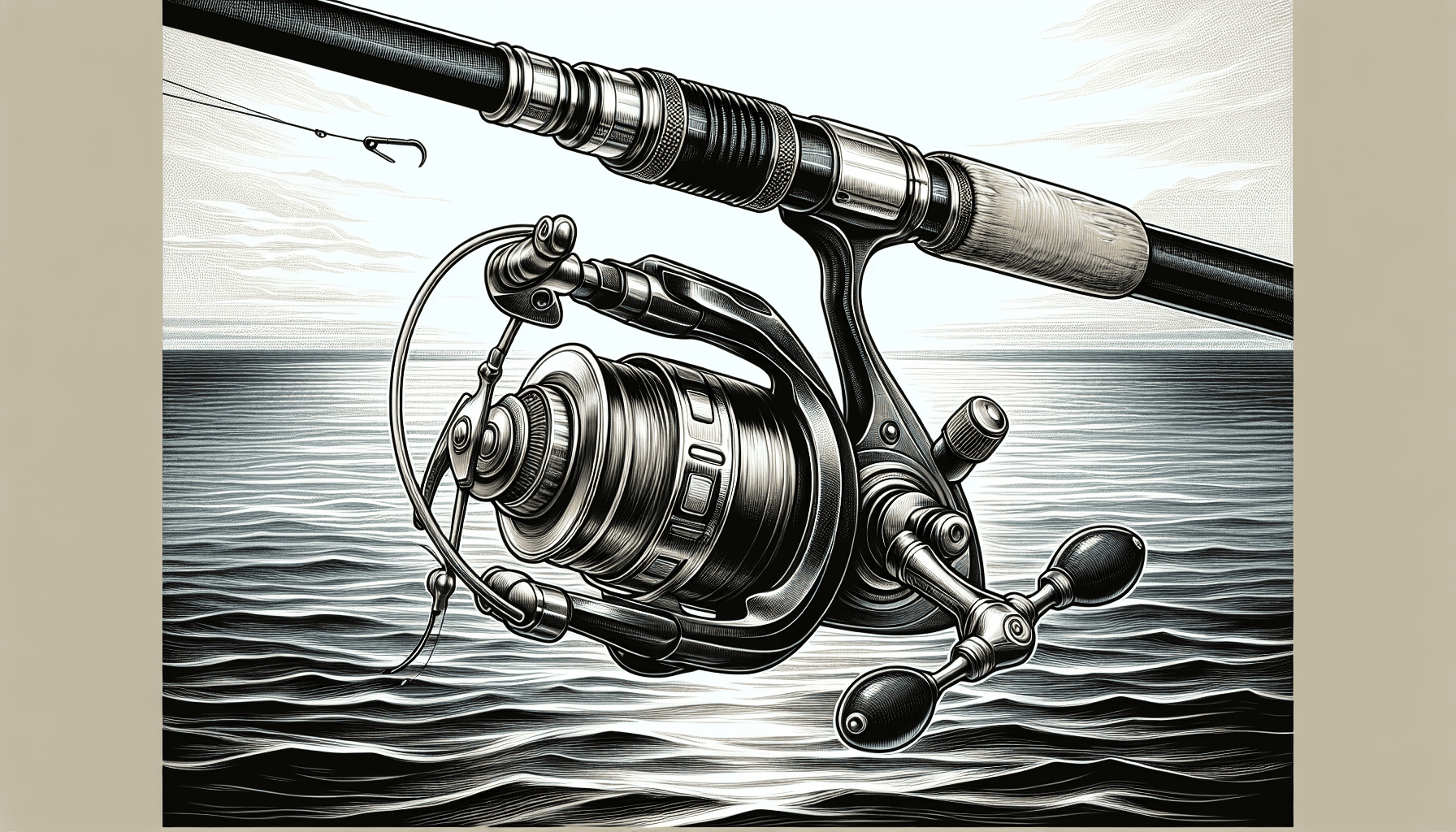
Equipping oneself with appropriate gear is fundamental in Sheepshead fishing. It’s not just about the bait, but also about the rod, the reel, and the hook you use. A 6 to 7-foot medium rod, which offers an excellent balance of sensitivity and power for pulling fish from rocky structures, is recommended.
When it comes to reels and lines, optimal combinations include a 3000 series reel, paired with light spinning or baitcasting tackle. Using 10-20 lb braided line coupled with a 15-20 lb fluorocarbon leader is advisable for stealth and strength. As for hooks, the #1 Octopus hook by Gamakatsu is a popular choice among Sheepshead fishers for its efficiency, with a general recommendation of using a #1 or 1/0 circle hook.
Having covered the basics, we can now delve into the specifics of the perfect rod and reel combination, as well as optimal line and hook selection for Sheepshead fishing. Paying attention to the rod tip sensitivity is crucial for detecting subtle bites.
The Ideal Rod and Reel Combo
Choosing the right rod and reel combo will make all the difference in Sheepshead fishing. A medium rod is recommended as it allows you to better detect the subtle Sheepshead bites. A 6 to 7-foot medium rod is the sweet spot, providing the right balance of strength and sensitivity.
When it comes to reels, pairing your rod with a 2500 to 3000 series spinning reel spooled with 10 to 20 lb. braided line can handle the strength of Sheepshead. This combination ensures that you can feel the hit (bite), set the hook, and reel in your catch without any hiccups.
Line and Hook Selection
When it comes to line and hook selection, smaller is better. Use smaller hooks such as a #1 size for effectively hooking Sheepshead, due to their subtle biting nature. Common hook setups for Sheepshead include a #1 or 1/0 Octopus or circle hook and size 1/0 or 2/0 short-shank, live-bait hooks.
A preferred line weight for catching Sheepshead ranges from 10 to 20 pounds, and a fluorocarbon leader, recommended between 15 and 20 pounds, is suitable for Sheepshead fishing to ensure strength and invisibility. Remember, ultra-sensitive gear is recommended to detect the very subtle bites of Sheepshead, enhancing the chances of a successful hook-up.
Bait Tactics to Outsmart Sheepshead
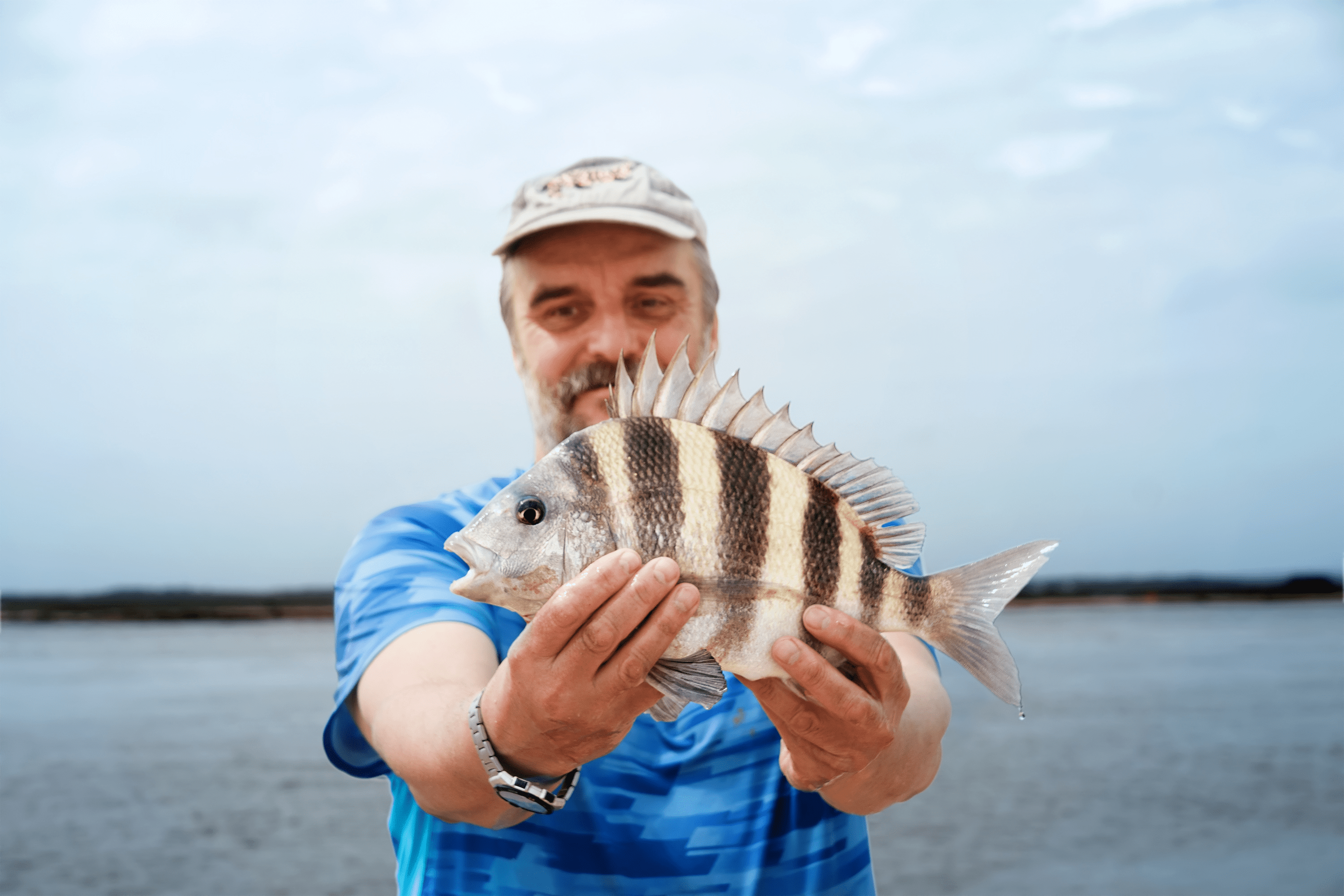
Progressing to a critical aspect of Sheepshead fishing – the bait. Sheepshead are enticed by a variety of baits such as mussels, shrimp, and barnacles due to their omnivorous diet. However, live shrimp are a top choice for live bait as Sheepshead are naturally inclined to feed on them in their environment.
Another effective bait is sand fleas, fiddler crabs, and small mud crab. Bottom sweeper-weighted jigs with a specific hook design can minimize bait theft, with the hook slid into the last two legs of a fiddler crab for an effective presentation. To further enhance your chances of success, consider using the pull fish technique to attract more attention from your target species.
Additionally, the High Low Rig is advantageous in Sheepshead fishing as it allows anglers to offer Sheepshead a choice between two different baits and identify their preference while fishing vertically.
Live Bait vs. Frozen Shrimp
At this point, you might question whether to opt for live bait or frozen shrimp. While each has its merits, live shrimp are generally superior to frozen shrimp as bait. They move and attract Sheepshead more effectively due to their natural movements. Plus, live shrimp emit a distinctive aroma that attracts Sheepshead, whereas frozen shrimp may lose some of their scent.
One thing to remember, however, is that frozen shrimp need time to thaw before use; otherwise, they may fall off the hook as they thaw underwater. So if you’re going for frozen shrimp, make sure to plan ahead.
Keeping Your Bait Close
Another significant factor in Sheepshead fishing is bait placement. Presenting bait close to underwater structures increases the chances of attracting Sheepshead, which often feed around such areas. Employing a weedless rig with a live shrimp helps prevent the hook from getting caught on the structure, keeping the bait where Sheepshead are actively feeding.
Also, when using sand fleas or fiddler crabs, twisting them onto the weighted portion of a jig allows the bait to sit under the hook’s barb, ensuring Sheepshead must bite the hook to reach the bait. This tactic can significantly increase your chances of a successful catch.
Rigs and Techniques for Sheepshead Success

Next, let’s scrutinize the fine details of rigs and techniques utilized in Sheepshead fishing. Mastering these techniques can significantly boost your Sheepshead fishing success. For instance, delaying the hook set with small circle hooks is crucial due to their quick bite and smaller mouth, allowing the fish to hook themselves.
Two popular rigs used in Sheepshead fishing are the Sliding Sinker rig and the Carolina rig. The Sliding Sinker rig allows the bait to stay near the bottom where Sheepshead tend to feed and enables quick changes in weight if needed. On the other hand, the Carolina rig is favored by many anglers to maintain bait presentation in the water column and to adjust for multiple bait depths.
Mastering the Sliding Sinker Rig
To assemble a Sliding Sinker rig, follow these steps:
- Thread an egg sinker onto the line.
- Tie on a swivel.
- Attach a fluorocarbon leader with a Sheepshead hook.
- Use a light egg or bullet weight on the sliding sinker rig to maintain the fine sensitivity needed to detect the often subtle bite of a sheepshead.
Adjusting the weight on the rig is also crucial. Ensure it keeps the bait near the underwater structures, which will vary based on the tidal conditions. In waters over 8 feet deep, utilize minimal weight on the sliding sinker rig, pairing a 15lb fluorocarbon leader with a stronger 20lb braid for optimal Sheepshead fishing.
The Art of the Carolina Rig
The Carolina Rig, on the other hand, involves using a leader to separate the bait from the weight. This separation can be adjusted in length depending on the depth, with a suggested line strength of 15lb to 20lb test fluorocarbon to adapt to various structures.
Anglers prefer to use the least amount of weight possible on a Carolina rig to maintain high sensitivity, allowing for better detection of the Sheepshead’s light bite in deeper waters. Also, a #1 or 1/0 size hook is the recommended size, providing a suitable balance for the typical size of Sheepshead and the type of bait used.
Advanced Sheepshead Fishing Strategies
You’ve mastered the basics, but what about the more sophisticated strategies? Well, we’ve got you covered. Creating a chum slick consisting of crushed barnacles or oyster shells can draw Sheepshead into the area. Dropping chum down structures can lead to schooling of Sheepshead around piles and docks, making them easier to target. If you are harvesting oysters for chum ensure that you are abiding by the rules and regulations in the state of Florida.
Effective chumming for Sheepshead involves distributing the chum both at the surface and near the bottom to engage fish at all levels. In addition to chumming, recognizing the subtle bites of Sheepshead is crucial, as they are adept at stealing bait without getting caught.
Reading Sheepshead Behavior
Reading Sheepshead behavior is another advanced strategy that can greatly improve your fishing success. During summer months, Sheepshead adapt their feeding habits to follow high tides into shallow inshore waters and grass flats in search of crabs.
The subtle nature of Sheepshead requires anglers to:
- Be patient
- Effectively disguise their fishing setup to entice a bite
- Ensure their line drifts towards underwater structures to increase their chances of a successful catch.
Best Sheepshead Fishing Spots in Florida

Having discussed the techniques, let’s identify the prime locations for Sheepshead fishing in Florida. Some of the top locations include:
- Clearwater
- Destin
- Islamorada
- Sarasota
- St. Petersburg
- Tampa
- Crystal River
Each of these locations provides unique opportunities for Sheepshead fishing. For instance, the Tampa Bay area is renowned for its Sheepshead fishing, especially around the numerous bridge pilings where these fish are often found. In Sarasota, anglers can take advantage of both inshore and nearshore waters that are popular spots for catching Sheepshead.
Whether it’s the diverse fishing opportunities in Clearwater, including speckled trout, the inshore, nearshore, and jetty fishing experiences in Destin, or the exceptional flats and inshore fishing in Islamorada, each location presents a unique opportunity to catch Sheepshead.
Preparing Your Sheepshead Catch
After a fruitful day of Sheepshead fishing, it’s time to relish your hard-earned catch. Preparing your Sheepshead catch involves cleaning and cooking the fish. An electric fillet knife is recommended by experienced anglers for cleaning Sheepshead as it is super fast, easy, and leaves no meat behind.
When cleaning a Sheepshead, make the incision along the lateral line to efficiently navigate over the rib cage, avoiding any unnecessary dulling of the blade since there is no meat on the rib cage. Now, it’s time to cook. To grill Sheepshead fillets, start by drying the fillets, coat with olive oil, apply seasoning, grill the seasoned side first, then after flipping, season the other side.
For those who prefer cooking a whole sheepshead, here’s a simple method:
- Gut the fish and spray it down to remove any slime.
- Grill the fish whole until the top skin peels off in one piece, which indicates that the fish is fully cooked.
- Season the fish to your liking and enjoy, being careful to remove any bones.
Ensure that your fish is fully cooked throughout
Rules and Regulations
To protect the populations of Sheepshead in Florida, there are certain rules and regulations in place throughout the state
- Minimum Size Limit: 12″ total length
- The Daily Bag Limit is 8 per person and 50 per Vessel during March and April
- Open season year-round
These rules are put in place for the preservation of the species. Check the regulations before fishing, as they can change from time to time.
Summary
Sheepshead fishing in Florida is an exciting and rewarding experience, from understanding the behavior and habitats of Sheepshead, selecting the right gear, mastering bait tactics, and exploring advanced strategies. Whether you’re a seasoned angler or a novice, these techniques and insights can help you master the art of catching sheepshead. So, why wait? Cast a line, and embrace the thrill of the tug!
Frequently Asked Questions
What is the best bait for sheepshead in Florida?
The best bait for Sheepshead in Florida is live shrimp, fiddler crabs or small mud crabs, although sand fleas, barnacles, and small pieces of frozen or cut shrimp can also be effective. Give these baits a try next time you’re out fishing for Sheepshead!
What is the secret to catching Sheepshead?
The secret to catching Sheepshead is to use chumming as a popular method. You can naturally chum the water by smashing and scraping barnacles into the water off a flow troll bait bucket (if you have one in the water for about a week) however, do not scrap barnacles off pilings or piers.
What is the best time to catch Sheepshead?
The best time to catch Sheepshead is during the winter when they tend to move offshore, and then gradually make their way into inshore waters as the water warms up. You can also go wade fishing from September to November, especially during high tides and when inshore bait stocks are at their peak.
How do you catch a Sheepshead in Florida?
You can catch Sheepshead in Florida by sight fishing for them around oyster bars and mud flats at low tide, as they search for Shrimp and Crabs around oyster clumps. Look for them being vertical in the water column, flipping over oyster clumps to eat.
What are some good spots for Sheepshead fishing in Florida?
You can find great Sheepshead fishing spots in Clearwater, Destin, Islamorada, Sarasota, St. Petersburg, Tampa, and Crystal River in Florida. Happy fishing!


